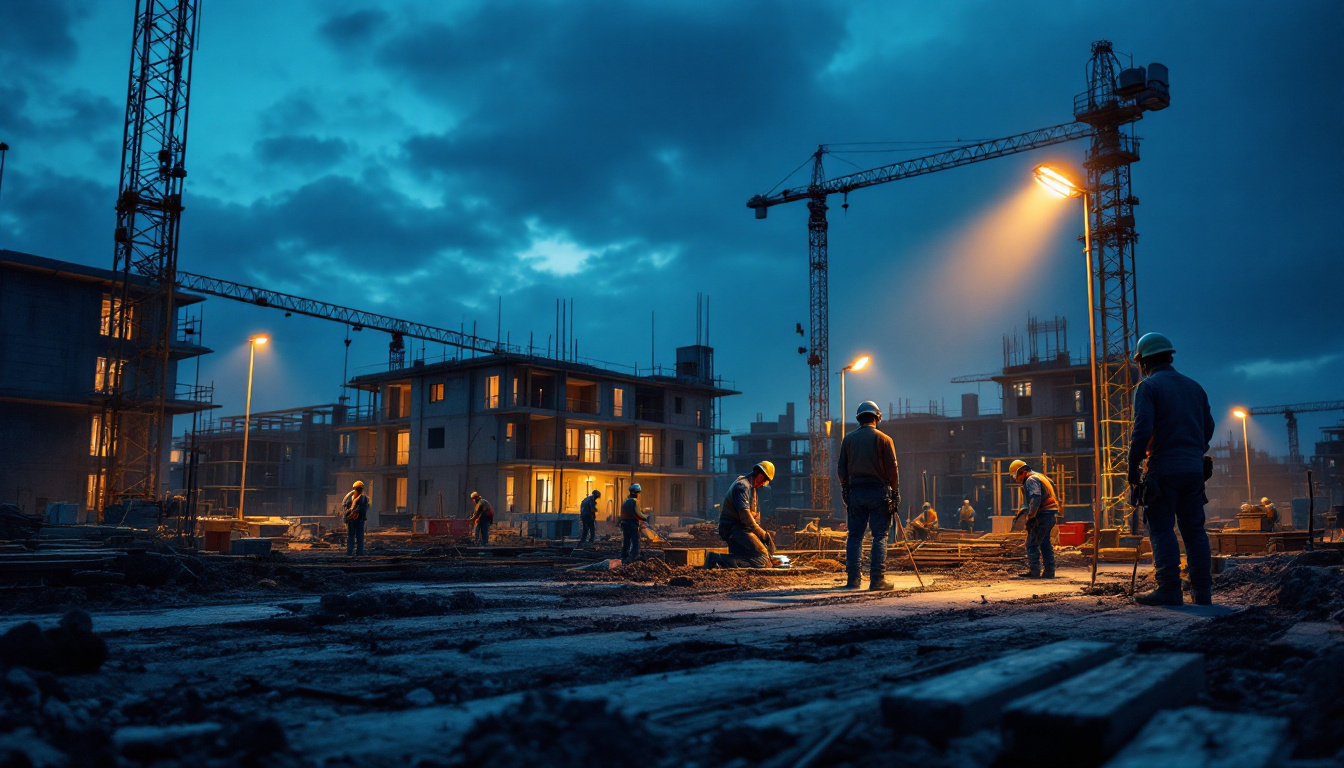
In the construction industry, proper lighting is essential for safety, efficiency, and productivity. Lighting contractors play a critical role in ensuring that work sites are adequately illuminated, allowing workers to perform their tasks safely and effectively. However, the selection and implementation of construction work lights can be a complex task. Understanding the do’s and don’ts can help lighting contractors make informed decisions that enhance both safety and operational efficiency.
One of the primary considerations in choosing construction work lights is the type of lighting technology being utilized. LED lights have gained popularity due to their energy efficiency, long lifespan, and lower heat emission compared to traditional incandescent or halogen lights. This not only reduces energy costs but also minimizes the risk of burns or heat-related accidents on site. Furthermore, LED lights are available in various brightness levels and color temperatures, allowing contractors to tailor the lighting to specific tasks and environments. For instance, cooler color temperatures can enhance visibility for detailed work, while warmer tones may be more comfortable for general site illumination.
In addition to technology, the placement and positioning of work lights are crucial for maximizing their effectiveness. Properly positioned lights can eliminate shadows and dark spots, which are common hazards on construction sites. Lighting contractors must consider the layout of the site, the nature of the work being performed, and the movement of workers and equipment throughout the day. Temporary lighting solutions, such as portable floodlights or string lights, can be particularly useful in adapting to changing site conditions, ensuring that workers always have adequate visibility regardless of the time of day or weather conditions. By prioritizing both the type and placement of lighting, contractors can significantly enhance the safety and productivity of construction operations.
Construction sites often operate under challenging conditions, including low visibility and varying weather. The right lighting not only improves visibility but also helps in identifying hazards, reducing accidents, and enhancing overall site safety. Furthermore, effective lighting can boost worker morale and productivity, as employees are more likely to perform well in a well-lit environment. Adequate lighting can also facilitate better communication among team members, as it allows for clearer visual signals and reduces the likelihood of misunderstandings that can arise in dimly lit areas.
Moreover, the type of lighting used can influence the overall atmosphere of the worksite. Natural light, when available, is often the most beneficial, as it has been shown to improve mood and cognitive function. However, in situations where artificial lighting is necessary, using a combination of ambient, task, and accent lighting can create a more dynamic and engaging work environment. This thoughtful approach to lighting design can lead to a more positive experience for workers, ultimately contributing to a more cohesive team dynamic.
Safety is paramount on any construction site. Poor lighting can lead to accidents, injuries, and even fatalities. It is crucial to ensure that all areas of the site are well-lit, especially those that are prone to hazards, such as stairways, scaffolding, and equipment zones. By prioritizing safety through proper lighting, contractors can significantly reduce the risk of workplace incidents. Additionally, implementing motion-sensor lights in high-traffic areas can further enhance safety by ensuring that light is available when needed, while also conserving energy when the site is unoccupied.
Regular maintenance of lighting fixtures is also essential to uphold safety standards. Burnt-out bulbs or malfunctioning lights can create dark spots that pose risks to workers. Establishing a routine inspection schedule for lighting systems can help identify issues before they become hazardous. Furthermore, training workers on the importance of reporting lighting problems can foster a culture of safety, where everyone is vigilant and proactive in maintaining a secure work environment.
Inadequate lighting can slow down work processes, as workers may struggle to see their tasks clearly. By investing in high-quality work lights, contractors can enhance productivity. Well-lit areas allow workers to complete their tasks more efficiently, leading to timely project completion and potentially reducing labor costs. Additionally, the strategic placement of lighting can minimize shadows and glare, which can be distracting and lead to errors. This attention to detail not only improves the quality of work but also instills confidence in workers as they navigate their tasks.
Moreover, the integration of adjustable lighting solutions can cater to the specific needs of various tasks. For instance, areas requiring precision work may benefit from focused, bright lighting, while general areas can utilize softer ambient lighting. This adaptability allows workers to perform at their best, regardless of the specific demands of their role. Investing in innovative lighting technology, such as LED systems that offer adjustable brightness and color temperature, can further enhance the work environment, ensuring that workers have the optimal conditions to thrive throughout the day.
To ensure effective lighting on construction sites, there are several best practices that lighting contractors should follow. These do’s can help create a safer and more productive work environment.
Before selecting lighting solutions, it is crucial to assess the specific needs of the construction site. Consider factors such as the size of the area, the type of work being performed, and the overall layout. Each site will have unique requirements, and understanding these will guide the selection of appropriate lighting fixtures.
Different types of work lights serve various purposes. For instance, LED lights are energy-efficient and have a longer lifespan compared to traditional incandescent bulbs. They provide bright, focused light that can illuminate large areas effectively. On the other hand, portable work lights are ideal for tasks requiring mobility. Selecting the right type of lights based on the specific tasks and conditions of the site is essential for optimal performance.
The placement of work lights is as important as the type of lights used. Lights should be positioned to minimize shadows and ensure that all areas are adequately illuminated. Consider using adjustable fixtures that can be moved as needed to adapt to changing site conditions. Additionally, be mindful of glare and ensure that lights do not hinder visibility for workers.
While there are many best practices to follow, there are also common pitfalls to avoid. Understanding these don’ts can help lighting contractors sidestep potential issues that could compromise safety and efficiency.
One of the most critical aspects of setting up construction work lights is ensuring a reliable power source. Relying on inadequate or temporary power solutions can lead to outages and interruptions. It is essential to evaluate the power requirements of the lighting fixtures and ensure that the site can support them without risking overloads or failures.
Construction sites are often exposed to various weather conditions, which can affect lighting performance and safety. Using lights that are not rated for outdoor use can lead to electrical hazards and equipment failure. Always choose weather-resistant fixtures that can withstand rain, wind, and temperature fluctuations to maintain safety and functionality.
Regular maintenance of lighting equipment is crucial for ensuring consistent performance. Neglecting maintenance can lead to reduced light output, increased energy consumption, and potential safety hazards. Establish a routine maintenance schedule to check for burned-out bulbs, damaged fixtures, and any other issues that may arise.
With numerous options available in the market, selecting the right lighting solutions can be daunting. However, understanding the key features and benefits of various types of work lights can simplify the decision-making process.
LED work lights have gained popularity in recent years due to their energy efficiency and longevity. They consume less power while providing bright illumination, making them an excellent choice for construction sites. Additionally, LED lights are less prone to breakage, reducing replacement costs and downtime.
Halogen lights are another common option for construction sites. They provide bright, white light and have a relatively low initial cost. However, they consume more energy than LEDs and generate significant heat, which can be a safety concern. When using halogen lights, ensure proper ventilation to mitigate heat-related issues.
For tasks that require mobility, portable work lights are invaluable. These lights can be easily moved around the site, providing flexibility for various tasks. Many portable lights are equipped with rechargeable batteries, making them suitable for areas without access to power sources. When selecting portable lights, consider the battery life and brightness levels to ensure they meet site requirements.
Once the appropriate lighting solutions have been selected, it is essential to implement effective strategies for their use. This includes not only the physical setup but also ongoing management of the lighting systems.
Incorporating lighting controls can enhance the efficiency of work lights. Dimmers, timers, and motion sensors can help reduce energy consumption and extend the lifespan of lighting fixtures. For example, using motion sensors can ensure that lights are only on when workers are present, reducing unnecessary energy use during downtime.
As construction projects progress, the lighting needs may change. It is essential to regularly review and adjust the lighting setup to accommodate new tasks or changes in the site layout. Conducting periodic assessments can help identify areas that may require additional lighting or adjustments to existing fixtures.
Even with the best lighting solutions in place, worker training is crucial for maximizing safety and efficiency. Educating workers about the importance of proper lighting can foster a culture of safety on the construction site.
Regular safety briefings should include discussions about the lighting setup and its importance. Workers should be informed about the locations of lights, potential hazards related to lighting, and how to report issues. This proactive approach can help prevent accidents and ensure that everyone is aware of their responsibilities regarding lighting safety.
Encouraging workers to provide feedback on the lighting conditions can lead to improvements. They may identify areas that require better illumination or report issues with existing fixtures. By fostering open communication, contractors can make necessary adjustments and ensure that the lighting setup meets the needs of the workforce.
In the construction industry, effective lighting is not just a luxury; it is a necessity. By understanding the do’s and don’ts of construction work lights, lighting contractors can create safer, more productive work environments. From assessing site requirements to choosing the right lighting solutions and implementing effective strategies, each step plays a vital role in ensuring success. By prioritizing safety and efficiency through proper lighting, contractors can enhance the overall performance of their projects while safeguarding the well-being of their workforce.
Ultimately, the right approach to construction work lighting can lead to improved outcomes, reduced accidents, and greater satisfaction for both workers and contractors alike. Emphasizing the importance of lighting in construction will not only contribute to project success but also foster a culture of safety and efficiency that benefits everyone involved.
Ready to elevate your construction site with the best in lighting solutions? Look no further than LumenWholesale, where we specialize in providing contractors with high-quality, specification-grade lighting products at unbeatable wholesale prices. Say goodbye to local distributor markups and hello to our extensive selection that meets the highest industry standards. With LumenWholesale, you get the reliability and high performance you need for every project, plus the convenience of hassle-free bulk buying and free shipping. Don’t compromise on quality or value—discover wholesale lighting at the best value today and light up your construction sites with confidence and efficiency.

Discover how industrial style light fixtures can transform your space with their unique blend of functionality and aesthetics.

Discover essential tools and expert advice tailored for lighting contractors in this comprehensive guide.

Discover the essential resources lighting contractors rely on to master low voltage pot lights.

Discover the pitfalls of purchasing drop ceiling lights in bulk from local distributors.